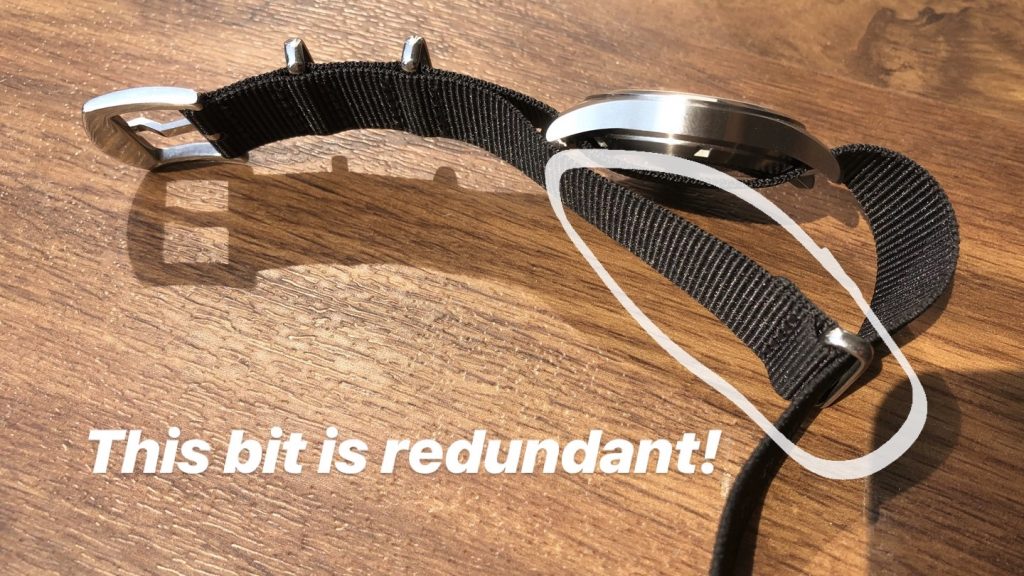Over the years I have had many interesting conversations with people who extoll the virtues of NATO straps, however its amazing how many people simple regurgitate what they have been told. While its true that by the inherent design of a NATO strap it secures the watch by passing a single piece of material through both spring bars, the additional piece of material behind it is simply not necessary and serves no useful purpose on a modern watch.
The idea of a NATO is that in the event of a single spring bar failure, the whole watch doesn’t fall of your wrist but the strap remains attached to your arm, and the watch head will still be there attached by the remaining single spring bar – and while this is not ideal, it means you haven’t damaged your watch by if falling off your wrist or worse still lost it entirely while swimming in a river or ocean.
However, the additional piece of material and added keeper was not designed for modern watches – it was designed for very old fashioned lugs that were curved much more than modern watches and allowed a leather single piece strap to pass through them the lugs without having to be ‘kinked’. If you were to pick up this kind of strap by the buckle, the watch would simply slide off the end of the strap – therefore by adding an additional piece of material and keeper, behind, the watch head would remain securely in place until the owner intentionally removed the strap.
However, this original design has remained a staple feature of the trusty NATO strap and has two rather undesirable consequences on a modern watch. As there are now two additional pieces of material behind the watch lifting it further away from your wrist, the fit and visual aesthetics mean it now looks much more bulky and clumsy than it would with a fitted strap. This is further confounded by the fact that there is limited adjustment on a NATO as to where the watch head sits, so although the buckle is hopefully on the underside of your wrist, the stitched in keepers are on one side of your wrist, and the other additional keeper is on the other side.

Tudor’s answer to this problem was to design and build a fabric strap that is a hybrid with two clever elements. It is a single piece of material with holes integrated into the material for the spring bars to slide through. Additionally, Tudor use a buckle with a sliding adjustment. This allows you to move the buckle along the strap for fine adjustment ensuring it sits comfortably on the underside of your wrist. This means Tudor’s watches sit closer to your wrist, are extremely comfortable, and look like the strap was designed for the watch rather than an afterthought.
However, although Tudor’s solution to the problem is elegant, there is a much simpler solution – make a simpler NATO strap. By making a NATO strap that does not include the second piece of material, you can position the watch head anywhere on the strap ensuring the buckle is located on the underside of your wrist no matter how large or small your wrist, and with much cleaner aesthetics the watch sits closer to your wrist and looks smarter without buckles and keepers on the sides. In addition it is simpler to make, has less materials and would cost less – so everyone wins!
We’ve modified a NATO strap to see the difference and its really transformative! its comfy without compromise. Take a look to see for yourself:
[su_slider source=”media: 256,260,266″ height=”440″]
We would love strap manufacturers to start making simple NATO straps and from our discussions with friends in writing this article – they would too! What’s your view? Do you wear NATO straps? Do drop us a line and let us know what you think!
#SimpleNATO


3 Comments
Pingback: Haveston’s re-engineered NATO Strap – Wristworthy
Manufacturers are already producing NATO straps that exclude the second piece of material. Haveston is just one that comes to mind.
You’re right some are but not many. The vast majority of NATO strap suppliers are in fact just cranking the handle producing the same strap with little thought to the product. Haveston were one of a very few who actually understand and chose to create and market a variant like this. They’re not the only ones doing this, but we felt they are of note for their approach.